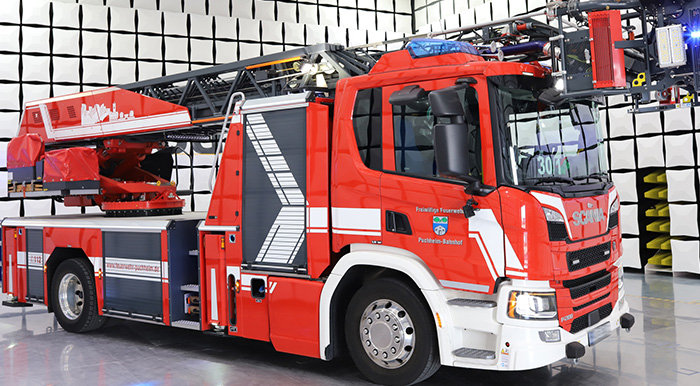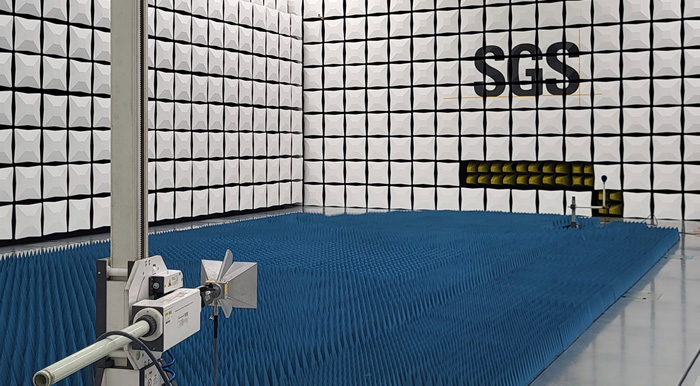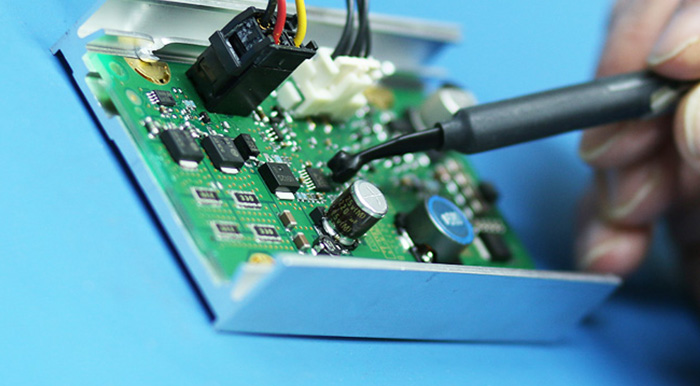Recognition as a conformity assessment body
The SGS EMC laboratory in Munich Germany is recognised by the Bundesnetzagentur (Federal Network Agency) as a Conformity Assessment Body (CAB) in the sector of electromagnetic compatibility (EMC) under the registration number BNetzA-CAB-14/21-09. This confirms that the laboratory has the competence to carry out the tasks of conformity assessment regarding to EMC within the framework of the agreement existing between the European Community and the United States of America.
With this prerequisite, the laboratory is also designated by the Federal Communications Commission (FCC) under the Designation Number DE0013 and the Test Firm Registration # 366296 as a CAB to perform compliance tests regarding EMC according to the approval procedures “Suppliers Declaration of Conformity (SDoC)” and “Certification” according to the relevant specifications of Part 15 and Part 18.
EMC requirements for electric and electronic equipment in the US market
Electrical and electronic products must comply with FCC regulations before they can be legally shipped, sold, imported, or offered for sale in the United States. The basic requirements are defined in CFR 47 §2.803 (Marketing of radio frequency devices prior to equipment authorization).
The FCC has defined different procedures for radio frequency devices depending on the type of equipment.
In §2.801 a radiofrequency device is defined as follows:
As used in this part, a radiofrequency device is any device which in its operation is capable of emitting radiofrequency energy by radiation, conduction, or other means. Radiofrequency devices include, but are not limited to:
(a) The various types of radio communication transmitting devices described throughout this chapter.
(b) The incidental, unintentional and intentional radiators defined in part 15 of this chapter.
(c) The industrial, scientific, and medical equipment described in part 18 of this chapter.
(d) Any part or component thereof which in use emits radiofrequency energy by radiation, conduction, or other means.
More precise definitions can also be found in §15.3 among others (k), (n), (o).
The 2 pillars of the Equipment Authorisation Program
In the past, the Equipment Authorization Program consisted of 3 pillars, including Verification, Declaration of Conformity (DoC) and Certification.
On July 13, 2017 the FCC adapted the program with the document “Report and Order FC 17-93” and combined the verification with the DoC to form the new “Supplier's Declaration of Conformity (SDoC)”. The transition period ended on November 2, 2018.
The selection of the approval procedure is essentially determined by the classification of the corresponding system regarding to unintentional or intentional radiator.
These are defined as follows:
- Unintentional Radiators
An unintentional radiator (defined in Section 15.3 (z)) is a device that by design uses digital logic, or electrical signals operating at radio frequencies for use within the product, or sends radio frequency signals by conduction to associated equipment via connecting wiring, but is not intended to emit RF energy wirelessly by radiation or induction.- Intentional Radiators
An intentional radiator (defined in Section 15.3 (o)) is a device that intentionally generates and emits radio frequency energy by radiation or induction that may be operated without an individual license.
§15.101 defines for unintentional radiators the application of the approval procedure SDoC or Certification. Certification is essentially required for intentional radiators.
Certification (see §2.907)
(a) Certification is an equipment authorization approved by the Commission or issued by a Telecommunication Certification Body (TCB) and authorized under the authority of the Commission, based on representations and test data submitted by the applicant.
(b) Certification attaches to all units subsequently marketed by the grantee which are identical (see § 2.908) to the sample tested except for permissive changes or other variations authorized by the Commission pursuant to § 2.1043.
Further information on certification is defined in §2.1031 to §2.1060.
EMC measurements for certification must be performed in FCC-accredited EMC laboratories, known as Conformity Assessment Bodies (CABs).
Supplier´s Declaration of Conformity SDoC (see §2.906)
SDoC is a procedure that requires the party responsible for compliance ensure that the equipment complies with the appropriate technical standards. The responsible party, who must be located in the United States, is not required to file an equipment authorization application with the Commission or a TCB. Equipment authorized under the SDoC procedure is not listed in a Commission database. However, the responsible party or any other party marketing the equipment must provide a test report and other information demonstrating compliance with the rules upon request by the Commission.
Further information on Supplier's Declaration of Conformity is defined in §2.1071 to §2.1077.
Important information in this context can be found in the FCC Public Notice DA 19-91 and especially in the Supplier's Declaration of Conformity Guidance 896810 D01 SDoC v02, which also contains the following important FCC sections:
- Section 2.906 Supplier’s Declaration of Conformity
- Section 2.909 Responsible party
- Section 2.931 Responsibilities
- Section 2.938 Retention of records
- Section 2.1072 Limitation on Supplier’s Declaration of Conformity
- Section 2.1074 Identification
- Section 2.1077 Compliance information
Please note, that one requirement of the SDoC among others is, that the Responsible Party must be based in the USA.
FCC Part 15 Emission Limit classes
According to §15.3 the relevant fields of application are defined as follows:
(h) Class A digital device. A digital device that is marketed for use in a commercial, industrial or business environment, exclusive of a device which is marketed for use by the general public or is intended to be used in the home.
(i) Class B digital device. A digital device that is marketed for use in a residential environment notwithstanding use in commercial, business and industrial environments. Examples of such devices include, but are not limited to, personal computers, calculators, and similar electronic devices that are marketed for use by the general public.
In accordance with the requirements of §15.105, the relevant limit class must be included in the system manual.
The relevant limits are similar, but not identical, to the limits of EN 55032 or EN 55011 known in Europe. Furthermore, the FCC requires that the equipment is operated with the US specific supply voltages during the EMC test. These are usually 120 V / 60 Hz or for larger consumers, double mains voltage 240 V / 60 Hz respectively three-phase alternating current with 208 V or 415 V / 60 Hz.
Marking of equipment
Devices falling within the scope of FCC Part 15 must be labeled in accordance with the requirements of §15.19.
The FCC defines clear requirements for marking as well as relevant information for the user of electronic systems within the scope of the various approval procedures. These can be found among others in:
- §15.19 Labeling requirements
- 784748 D01 General labeling and Notification v09r01: General guidelines for labeling and other information required to be provided to users
- 748748 D02 e labeling v02: Electronic labeling guidance
Among other things, it also defines how and under what conditions the FCC logo may be used.
If the device falls within the scope of FCC P.18, the requirements of §18.203 as well as §18.209 and §18.212 must be observed. Additionally, requirements from §15.21 regarding Information to the User and §15.27 regarding Special Accessories are defined.
Integration of radio modules
Many system manufacturers integrate radio modules that already have FCC approval. In this case, in addition to good RF knowledge, experience with EMC concepts and knowledge of the FCC regulations are required.
Using the approval of a modular transmitter has the advantage of reducing the requirements for later FCC filing. However, the manufacturers of the host products may only make limited modifications or changes to the modular transmitter and antenna types. The manufacturers of the host products are responsible for following the manufacturer's integration guidelines and performing a relevant selection of transmitter verification tests to ensure that the final product complies with FCC rules. Manufacturers of the host product are also responsible for any additional device approvals and tests for technical requirements not covered by the module approval.
Detailed information on the procedure and boundary parameters to be observed can be found in document: 996369 D04 Module Integration Guide v01 Modular Transmitter Integration Guide - Guidance for Host Product Manufacturers.
Contact
Armin Hudetz
t: +49 89 78 74 75-133
E-Mail: This email address is being protected from spambots. You need JavaScript enabled to view it.
Customer Service Team
t: +49 89 78 74 75-222
E-Mail: This email address is being protected from spambots. You need JavaScript enabled to view it.



